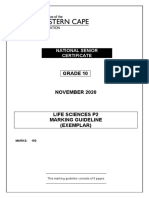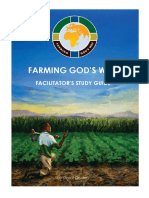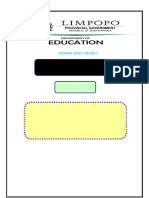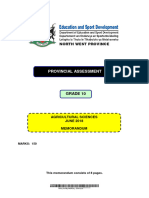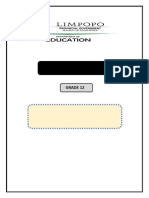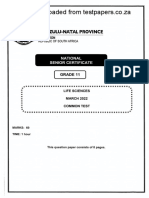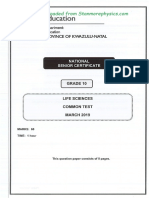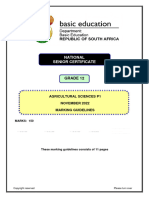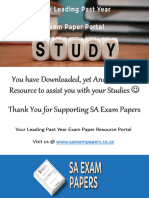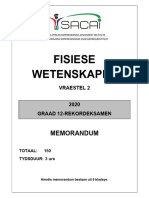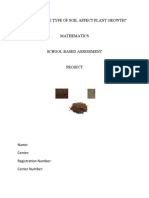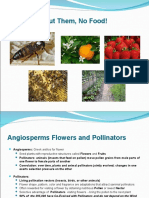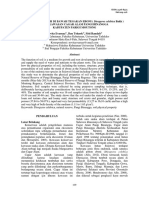Agric SC p2 Memo Gr11 Nov 2020 - English
Agric SC p2 Memo Gr11 Nov 2020 - English
Uploaded by
mahlatsethaga430Copyright:
Available Formats
Agric SC p2 Memo Gr11 Nov 2020 - English
Agric SC p2 Memo Gr11 Nov 2020 - English
Uploaded by
mahlatsethaga430Original Title
Copyright
Available Formats
Share this document
Did you find this document useful?
Is this content inappropriate?
Copyright:
Available Formats
Agric SC p2 Memo Gr11 Nov 2020 - English
Agric SC p2 Memo Gr11 Nov 2020 - English
Uploaded by
mahlatsethaga430Copyright:
Available Formats
NATIONAL
SENIOR CERTIFICATE
GRADE 11
NOVEMBER 2020
AGRICULTURAL SCIENCES P2
MARKING GUIDELINE
(EXEMPLAR)
MARKS: 150
This marking guideline consists of 9 pages.
2 AGRICULTURAL SCIENCES P2 (EC/NOVEMBER 2020)
SECTION A
QUESTION 1
1.1 1.1.1 A
1.1.2 C
1.1.3 B
1.1.4 C
1.1.5 B
1.1.6 C
1.1.7 C
1.1.8 A
1.1.9 D
1.1.10 D (10 x 2) (20)
1.2 1.2.1 H
1.2.2 E
1.2.3 F
1.2.4 B
1.2.5 A (5 x 2) (10)
1.3 1.3.1 Transpirational pull
1.3.2 Fertiliser
1.3.3 Pollination
1.3.4 Integrated Pest Management
1.3.5 Green house (5 x 2) (10)
1.4 1.4.1 Diffusion
1.4.2 Germination
1.4.3 Monoculture
1.4.4 Aquaculture
1.4.5 Survey (5 x 1) (5)
TOTAL SECTION A: 45
Copyright reserved Please turn over
(EC/NOVEMBER 2020) AGRICULTURAL SCIENCES P2 3
SECTION B
QUESTION 2: PLANT STUDIES (NUTRITION)
2.1 2.1.1 Process represented by the chemical equation
Photosynthesis (1)
2.1.2 Compound B
Glucose (1)
2.1.3 Plant organs where compound B is found
Leaves
Stems
Roots
Tubers
Bulbs (Any 2) (2)
2.1.4 Methods of speeding up the rate of photosynthesis
Use of greenhouses
Pruning
Trellising systems
Using optimum plant density (Any 2) (2)
2.2 2.2.1 Functions of water in plants
Provides mechanical rigidity to cells
Important in chemical reactions
A universal solvent
It serves as a transport medium
Temperature regulation (Any 2) (2)
2.2.2 Adaptation of the plant to reduce transpiration rate
Leaves are reduced
Photosynthesis occurs on stems
Stems store water
Stems are shiny to reflect heat waves and reduce
transpiration (Any 3) (3)
2.2.3 Consequences of lack of adaptations to reduce water loss
Plant cannot carry out metabolism due to lack water
Failure to regulate temperature
Failure to transport minerals and products of
photosynthesis
Wilting
Senescence (Any 2) (2)
2.3 2.3.1 Classification of inorganic fertiliser
Inorganic fertiliser (1)
Copyright reserved Please turn over
4 AGRICULTURAL SCIENCES P2 (EC/NOVEMBER 2020)
2.3.2 Examples of phosphorus fertilisers
Superphosphate / mono-calcium phosphate
Raw/rock phosphate (2)
2.3.3 Percentage nitrogen in a fertiliser bag
N = 280 g/1 000 g x 100
= 28% (2)
2.3.4 Evidence of state regulation of fertiliser production
Registration number
Act number 36 of 1947 (2)
2.4 2.4.1 Identification of structure C
Transport protein (1)
2.4.2 Identification of transport mechanisms
A – Passive uptake
B – Active uptake (2)
2.4.3 Motivation of answers to QUESTION 2.4.2
A does not require energy in the form of ATP while in B energy
is required
OR
In A movement is along concentration gradient while in B
movement is against concentration gradient (2)
2.5 2.5.1 Basal application (1)
2.5.2 Broadcasting (1)
2.5.3 Foliar application (1)
2.5.4 Band placing (1)
2.5.5 Fertigation (1)
2.6 2.6.1 Deduction of an advantage of green manuring
Soil conservation (1)
2.6.2 Explanation of the advantage of using leguminous plants
Legumes form a mutually symbiotic relationship with nitrogen fixing
bacteria, which improve the nitrogen content of the soil.
OR
Legumes are rich in proteins upon being ploughed under as green
manures they are decomposed by microbes to nitrogen containing
compounds increasing the soil’s nitrogen content. (2)
2.6.3 Advantages of green manuring
Reduces soil erosion
Improves soil fertility
Improves soil structure (Any 2) (2)
[35]
Copyright reserved Please turn over
(EC/NOVEMBER 2020) AGRICULTURAL SCIENCES P2 5
QUESTION 3: PLANT REPRODUCTION AND PROTECTION
3.1 3.1.1 Name of plant propagation method
Grafting (1)
3.1.2 Labelling
A – scion
B – rootstock (2)
3.1.3 Advantages of plant propagation method in QUESTION 3.1.1.
Fruit trees can be produced with several varieties
The appearance or form of a plant can be changed
An undesirable trait can be corrected
The scion can be grafted onto a healthier rootstock with a more
vigorous root system (Any 2) (2)
3.1.4 Examples of fruit trees propagated using grafting in South
Africa
Oranges
Lemons
Nartjie
Grapes
Macadamia
Avocado
Nectarines
Apples (Any 2) (2)
3.2 3.2.1 Name of phenomenon described in the passage
Ablactation (1)
3.2.2 Biological cause of ablactation in the passage
Inadequate pollination/thrips (1)
3.2.3 Climatic causes of ablactation
Frost
Excessive rain
Wind (Any 2) (2)
3.2.4 Methods of protecting crops from climatic factors mentioned
in QUESTION 3.2.3
Frost – tunnels/greenhouses/mulching
Excessive rain – greenhouses/tunnels
Wind – Shade houses/wind breaks/greenhouses/tunnels (Any 2) (2)
3.3. Matching propagation methods with appropriate plant
3.3.1 cuttings (1)
3.3.2 bulbs (1)
3.3.3 tubers (1)
3.3.4 rhizomes (1)
3.3.5 runners (1)
Copyright reserved Please turn over
6 AGRICULTURAL SCIENCES P2 (EC/NOVEMBER 2020)
3.4 3.4.1 Meaning of acronym GMO
Genetically Modified Organism (1)
3.4.2 Advantage of GM technology mentioned in the passage
Production of herbicide resistant plants (1)
3.4.3 Other methods of plant improvement in addition to GM
technology
Selection
Hybridisation
Mutation (Any 2) (2)
3.5 3.5.1 Environmental conditions that lead to rapid multiplication of
pathogens
Monocultures
High planting densities
High humidity
High temperatures (Any 2) (2)
3.5.2 Micro-organisms that cause diseases
Viruses
Bacteria
Fungi (Any 2) (2)
3.5.3 Measures for preventing spread of plant diseases
Remove all weeds
Avoid overcrowding plants
Use disease resistant varieties
Practise intercropping
Disinfect pruning tools
Practise crop rotation (Any 2) (2)
3.6 3.6.1 Matching insects with the statements given
(a) – A
(b) – C
(c) – B (3)
3.6.2 Advantages of using the pest control method in
QUESTION 3.6.1. (c)
Not harmful to the environment
No need to purchase expensive chemical pesticides (2)
3.6.3 Non-chemical pest control methods
Crop rotation
Biological control
Intercropping
Mechanical control
Burning (Any 2) (2)
[35]
Copyright reserved Please turn over
(EC/NOVEMBER 2020) AGRICULTURAL SCIENCES P2 7
QUESTION 4: OPTIMAL RESOURCE UTILISATION
4.1 4.1.1 Identification of drainage layouts
A – Grid system
B – Herringbone system (2)
4.1.2 Letter for the drainage layout which can be used in the given
cases
(a) B
(b) C
(c) A (3)
4.1.3 Factors farmers should consider when installing pipe drainage
systems
Pipe diameter
Depth of drains
Drain slope (Any 2) (2)
4.2 4.2.1 Example of a primary tillage implement
Plough
Ripper (Any 1) (1)
4.2.2 Main aim of secondary tillage
To break clumps of soil left by primary tillage implements (1)
4.2.3 Differentiate between primary and secondary cultivation
Primary tillage tends to produce a rough surface finish whereas
secondary tillage tends to produce a smoother surface finish. (2)
4.3 4.3.1 Identification of instruments A and B
A – Tensiometer
B – Class A evaporation pan (2)
4.3.2 Advantages of irrigation scheduling
Minimises crop water stress
Reduces the farmer’s cost of water and labour
Minimises waterlogging problems
Increases crop yields and quality (Any 2) (2)
4.3.3 Sources of water for irrigation
Lakes / dams
Permanent rivers / streams
Aquifers / springs / boreholes (2)
Copyright reserved Please turn over
8 AGRICULTURAL SCIENCES P2 (EC/NOVEMBER 2020)
4.4 4.4.1 Identification of the farming system
Precision farming (1)
4.4.2 Identify a piece of equipment which plays a central role in the
farming system in the scenario
GPS (1)
4.4.3 Deduction of TWO advantages of the system
Allows the farmer to compare harvest information and identify
poor spots in lands
Allows the farmer to see exactly how much has been harvested
from specific areas in the land (Any 2) (2)
4.4.4 Other pieces of equipment required for successful
implementation of precision farming
GIS maps
Computers
Satellites (Any 2) (2)
4.5 4.5.1 Table showing the response of a farmer’s crop to two
watering regimes
Maize yield (t)
Year
Rainfed Irrigated
2010 80 90
2011 120 140
2012 80 82
2013 60 80
2014 90 110
Marking checklist
Title
Units (t)
Correct rainfed yields
Correct irrigated yields
Correct years
Accuracy (6)
4.5.2 Water delivery method which results in higher yields
Irrigation (1)
4.5.3 Justification for answer to QUESTION 4.5.2
Irrigated fields had higher yields than rainfed fields over the
5 years (1)
4.5.4 Prediction of what could have caused the results in 2012
There were sufficient rains in 2012. As a result, there were no
significant differences between irrigated and rainfed fields. (2)
Copyright reserved Please turn over
(EC/NOVEMBER 2020) AGRICULTURAL SCIENCES P2 9
4.5.5 Challenges that limit the widespread adoption of irrigation
systems
Lack of water sources
Cost of installation and maintenance of the irrigation
systems
Lack of knowledge required to run and maintain the irrigation
systems (Any 2) (2)
[35]
TOTAL SECTION B: 105
GRAND TOTAL: 150
Copyright reserved Please turn over
You might also like
- LIFE SCIENCES P2 MEMO GR10 NOV2020 - EnglishDocument9 pagesLIFE SCIENCES P2 MEMO GR10 NOV2020 - EnglishMaxy100% (2)
- FGW Facilitators Study GuideDocument21 pagesFGW Facilitators Study GuideIQaba DyosiNo ratings yet
- Agr Sciences p2 Memo Gr11 Nov 2019 EnglishDocument10 pagesAgr Sciences p2 Memo Gr11 Nov 2019 Englishversagedoctor15No ratings yet
- Agricultural Sciences GRADE 11 P2 November 2022Document8 pagesAgricultural Sciences GRADE 11 P2 November 2022finehun16No ratings yet
- Agric Sciences p1 Gr11 Memo Nov2019 - Eng DDocument10 pagesAgric Sciences p1 Gr11 Memo Nov2019 - Eng Dhopep6572No ratings yet
- AGRS GRADE 11 P2 Memo EngDocument11 pagesAGRS GRADE 11 P2 Memo Engfinehun16No ratings yet
- Agric Sciences p1 Gr11 Memo Nov2019 - Eng DDocument9 pagesAgric Sciences p1 Gr11 Memo Nov2019 - Eng DmamabolotranquilNo ratings yet
- AGRIC SCIENCES P1 GR11 MEMO NOV2020 - EnglishDocument9 pagesAGRIC SCIENCES P1 GR11 MEMO NOV2020 - EnglishtinangxeksNo ratings yet
- Agric Sciences p1 Gr11 Memo Nov2019_eng D_hlayiso.comDocument9 pagesAgric Sciences p1 Gr11 Memo Nov2019_eng D_hlayiso.comwehideguiltNo ratings yet
- AGRS_Grade 11_Memo_ June_2024EngDocument10 pagesAGRS_Grade 11_Memo_ June_2024Engfinehun16No ratings yet
- 2024 04 18 MW LFSC Topic Test 4 Gr11 MG EngDocument3 pages2024 04 18 MW LFSC Topic Test 4 Gr11 MG EngSekgobela M. MirandaNo ratings yet
- Agric Sciences p1 Gr10 Memo - EnglishDocument11 pagesAgric Sciences p1 Gr10 Memo - EnglishrukudzokadiraNo ratings yet
- NW NSC GR 11 Agric Sciences P1 Eng Memo Nov 2019Document10 pagesNW NSC GR 11 Agric Sciences P1 Eng Memo Nov 2019mankgelebogang03No ratings yet
- Nw Gr 10 Agric Sc p1 Eng Memo Nov 2019 Hlayiso.comDocument10 pagesNw Gr 10 Agric Sc p1 Eng Memo Nov 2019 Hlayiso.comthabangadelaide24No ratings yet
- NW NSC GR 10 Agric SC p1 Eng Memo Nov 2019Document10 pagesNW NSC GR 10 Agric SC p1 Eng Memo Nov 2019liyabonakalawe43No ratings yet
- Grade 10 Pre Midyear MG 2024Document7 pagesGrade 10 Pre Midyear MG 2024reitumetsedimpane6No ratings yet
- AGRIC SCIENCES P1 GR10 MEMO - EnglishDocument10 pagesAGRIC SCIENCES P1 GR10 MEMO - EnglishphashqonthatileNo ratings yet
- Agricultural Management Practices Nov 2023 MG EngDocument13 pagesAgricultural Management Practices Nov 2023 MG EngCamille RobinsonNo ratings yet
- Agric Sc p2 Memo Gr11 Nov2020 Eng D_hlayiso.comDocument9 pagesAgric Sc p2 Memo Gr11 Nov2020 Eng D_hlayiso.comwehideguiltNo ratings yet
- Agricultural Sciences P1 May-June 2023 MG EngDocument10 pagesAgricultural Sciences P1 May-June 2023 MG EngkristenxabaNo ratings yet
- Agric Science P1 Grade 11 November Marking Guidelines 2022Document11 pagesAgric Science P1 Grade 11 November Marking Guidelines 2022finehun16No ratings yet
- LFSC-P2-N12-MEMO-EngDocument7 pagesLFSC-P2-N12-MEMO-Eng9vf9cbmjtdNo ratings yet
- Agricultural Management Practices NSC Memo Nov 2022 EngDocument16 pagesAgricultural Management Practices NSC Memo Nov 2022 EngmidkaraboNo ratings yet
- 2018-Feb-March-Agricultural-Sciences-Memo-1-EnglishDocument11 pages2018-Feb-March-Agricultural-Sciences-Memo-1-EnglishbhululusibahleNo ratings yet
- 1 GIb XJZM 2 XNX WEx 3 E1-Hit EIy GT15 P EaDocument8 pages1 GIb XJZM 2 XNX WEx 3 E1-Hit EIy GT15 P EaAndzaniNo ratings yet
- Agricultural Sciences P1 May-June 2021 MG EngDocument10 pagesAgricultural Sciences P1 May-June 2021 MG EngOratile SeichokeloNo ratings yet
- Agricultural Sciences P1 Feb-March 2018 Memo EngDocument10 pagesAgricultural Sciences P1 Feb-March 2018 Memo Engfrans NgobeniNo ratings yet
- Provincial Assessment: Grade 10Document8 pagesProvincial Assessment: Grade 10amandaNo ratings yet
- Agricultural Sciences P1 Nov 2020 Memo EngDocument12 pagesAgricultural Sciences P1 Nov 2020 Memo EngMamosa BotsheloNo ratings yet
- PACK 2 MG 2024Document11 pagesPACK 2 MG 2024kelebogileyandaNo ratings yet
- Agr Sciences p2 Gr11 Memo Nov2018 - EnglishDocument10 pagesAgr Sciences p2 Gr11 Memo Nov2018 - English1979mojafiNo ratings yet
- Agricultural Sciences P1 Nov 2018 FINAL MEMO Eng.Document9 pagesAgricultural Sciences P1 Nov 2018 FINAL MEMO Eng.msanen023No ratings yet
- NSC June 2018 Agricultural Sciences P1 MemoDocument10 pagesNSC June 2018 Agricultural Sciences P1 Memomsanen023No ratings yet
- Agr Sciences p1 Gr10 Memo Nov2019 English.Document10 pagesAgr Sciences p1 Gr10 Memo Nov2019 English.Mdluli lindoNo ratings yet
- AGRIC SCIENCES P2 MEMO JUNE2021 - EnglishDocument12 pagesAGRIC SCIENCES P2 MEMO JUNE2021 - Englishthabokuhle25hNo ratings yet
- Natural Sciences Grade 8 Term 2 Memorandum 2023Document5 pagesNatural Sciences Grade 8 Term 2 Memorandum 2023staquinasbkNo ratings yet
- Agricultural Sciences MemoDocument9 pagesAgricultural Sciences Memomakhensa345No ratings yet
- LifeDocument13 pagesLifebellaNo ratings yet
- NW-NSC-GR-10-AGRIC-SC-P2-ENG-MARKING-GUIDELINES-NOV-2019_Document10 pagesNW-NSC-GR-10-AGRIC-SC-P2-ENG-MARKING-GUIDELINES-NOV-2019_mogaolowilly524No ratings yet
- 1 Da S63 M 1 A5 Ycv Pce MF TD CJZ 8 FHMYqs NViDocument12 pages1 Da S63 M 1 A5 Ycv Pce MF TD CJZ 8 FHMYqs NViYaziNo ratings yet
- Agricultural Sciences P1 May-June 2022 MG EngDocument10 pagesAgricultural Sciences P1 May-June 2022 MG Engrebeccamichael795No ratings yet
- Agricultural Sciences P1 May June 2018 Memo EngDocument11 pagesAgricultural Sciences P1 May June 2018 Memo Engmsanen023No ratings yet
- Agricultural Sciences P1 Nov 2022 MG EngDocument11 pagesAgricultural Sciences P1 Nov 2022 MG Engamandashabalala1237No ratings yet
- LFSC March QP & Memo 2019 Gr10Document12 pagesLFSC March QP & Memo 2019 Gr10Erasmus MutsilaNo ratings yet
- Agricultural Sciences P1 May June 2021 Memo EngDocument11 pagesAgricultural Sciences P1 May June 2021 Memo EngradisegoanedialeNo ratings yet
- Agricultural Sciences P1 MGDocument10 pagesAgricultural Sciences P1 MGdidimabuyeNo ratings yet
- AGRSC P2 GR11 MEMO ENG SEPT2015Document10 pagesAGRSC P2 GR11 MEMO ENG SEPT2015ramagoshibeverlythatoNo ratings yet
- Agricultural Sciences NSC Memo P1 Sept 2021 EngDocument11 pagesAgricultural Sciences NSC Memo P1 Sept 2021 Engswazidlamini024No ratings yet
- Lim Physical Sciences p2 Memo-Pre-Trial-Memo Eng-5510858Document9 pagesLim Physical Sciences p2 Memo-Pre-Trial-Memo Eng-5510858owamii.mncwabeeNo ratings yet
- Grade 10 Sba Controlled Test 3Document10 pagesGrade 10 Sba Controlled Test 3mondlimondli104100% (1)
- Soil EcologyDocument678 pagesSoil Ecologyalvaro diazNo ratings yet
- Agricultural Sciences P1 May June 2022 MG EngDocument11 pagesAgricultural Sciences P1 May June 2022 MG Engsuprisent53No ratings yet
- Agricultural Sciences P1 May-June 2017 Memo EngDocument10 pagesAgricultural Sciences P1 May-June 2017 Memo EngLENCELORDNo ratings yet
- Grade 10 Term 3 Pre-Test MGDocument8 pagesGrade 10 Term 3 Pre-Test MGjanlekwapa2No ratings yet
- Agricultural Sciences Memo June 2021 EngDocument12 pagesAgricultural Sciences Memo June 2021 Engmsanen023No ratings yet
- 2023 Agrs gr 12 MGDocument8 pages2023 Agrs gr 12 MGKenNo ratings yet
- AGR SCIENCES P1 GR10 MEMO NOV2019_English_hlayiso.com_._hlayiso.com_Document10 pagesAGR SCIENCES P1 GR10 MEMO NOV2019_English_hlayiso.com_._hlayiso.com_sukanichabalala813No ratings yet
- 2020-FW-Graad 12-Rekordeksamen Memorandum - Vraestel 2Document9 pages2020-FW-Graad 12-Rekordeksamen Memorandum - Vraestel 2AliceNo ratings yet
- Agricultural Sciences P1 Nov 2023 MG EngDocument11 pagesAgricultural Sciences P1 Nov 2023 MG Engsnenhlanhlatshezi22No ratings yet
- AGRIC SCIENCES P2 GR11 QP NOV2022_EnglishDocument12 pagesAGRIC SCIENCES P2 GR11 QP NOV2022_Englishlekoalarethabile9No ratings yet
- Green Reaction Media in Organic SynthesisFrom EverandGreen Reaction Media in Organic SynthesisKoichi MikamiNo ratings yet
- Quiz HorticultureDocument3 pagesQuiz Horticulturecaballes.melchor86No ratings yet
- Introduction To Postharvest HandlingDocument27 pagesIntroduction To Postharvest HandlingNemie Rex Sukil-ap GuerzonNo ratings yet
- Past & Present Status of Agriculture and FarmersDocument41 pagesPast & Present Status of Agriculture and FarmersStalinNo ratings yet
- Seminar IIDocument39 pagesSeminar IImajiu58No ratings yet
- WEEK4 SoilDocument32 pagesWEEK4 SoilMarienne Sophia CabalNo ratings yet
- Yurts of Mongolia 1Document20 pagesYurts of Mongolia 1yazhini sambanthan A Sec100% (1)
- Business Report WritingDocument14 pagesBusiness Report WritingHammad MirzaNo ratings yet
- Botany Arjun Shyonak PalanduDocument6 pagesBotany Arjun Shyonak PalanduPrajkta AbnaveNo ratings yet
- Its Country For MeDocument3 pagesIts Country For MeR.ArifNo ratings yet
- A Reflection Essay By: A Leader, A LadderDocument3 pagesA Reflection Essay By: A Leader, A LadderRoland EmersonNo ratings yet
- 21st CenturyDocument4 pages21st CenturyEdsel AlapagNo ratings yet
- Kinghitter Pricelist 2021 (Print Ready)Document16 pagesKinghitter Pricelist 2021 (Print Ready)GwyddonNo ratings yet
- Event Register: Smallholder Agricultural Competitiveness Project (SACP)Document5 pagesEvent Register: Smallholder Agricultural Competitiveness Project (SACP)Joy BiswasNo ratings yet
- 2011-6265 FinalDocument30 pages2011-6265 FinalTIVIYAH THEVAR 1017No ratings yet
- Sample SBADocument15 pagesSample SBATisanya DavisNo ratings yet
- When To Sow AdviceDocument24 pagesWhen To Sow Adviceshahab76pakNo ratings yet
- STEM BeesDocument36 pagesSTEM BeesHitesh YadavNo ratings yet
- Sickle FinalreportDocument58 pagesSickle FinalreportAmar PatroNo ratings yet
- 3621 11403 1 PBDocument8 pages3621 11403 1 PBFaizal Nur FahmiNo ratings yet
- GROUP 2 Agriculture SectorDocument15 pagesGROUP 2 Agriculture SectorAldeon NonanNo ratings yet
- Short Story From InternetDocument15 pagesShort Story From InternetMaralene de Leon (Cho)No ratings yet
- Vaname Shrimp Cultivation Litopenaeus Vannamei On High Stocking Densities in Controlled PondsDocument6 pagesVaname Shrimp Cultivation Litopenaeus Vannamei On High Stocking Densities in Controlled PondsEl DrogoNo ratings yet
- Forestry KcseDocument15 pagesForestry Kcsevictorkapere1No ratings yet
- Grade 9 Notes Food Security 2Document2 pagesGrade 9 Notes Food Security 2Rehan ShajimonNo ratings yet
- Pollen Grain 2.00Document5 pagesPollen Grain 2.00TECO ASTRANo ratings yet
- Saroj Dulal - Pest Management Practices by Commercial Farmers in Kakani Rural MuncipalityDocument123 pagesSaroj Dulal - Pest Management Practices by Commercial Farmers in Kakani Rural MuncipalitySaroj DulalNo ratings yet
- Social Grade 8Document127 pagesSocial Grade 8KIdus GetaNo ratings yet
- Geolife Brochure PDFDocument11 pagesGeolife Brochure PDFSaravana Bharathy ReddyNo ratings yet
- Globalization and PovertyDocument9 pagesGlobalization and PovertyPuslica PloticicNo ratings yet
